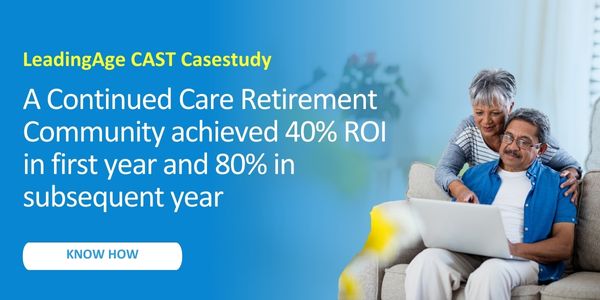AI Solutions for Aging Services: Enhancing Provider-Resident Experience
Current scenario of LTPAC Providers and Communities
As the population ages and the demand for long-term care services grows, the aging industry is
facing significant challenges. A shortage of qualified and interested workers, limited funding, and the
need to meet strict regulatory standards are just a few of the obstacles that senior living
communities and other long-term care facilities must overcome sooner.
According to data from World Population Prospects: the 2019 Revision, the proportion of people
over the age of 65 is expected to rise from 9% in 2019 to 16% by 2050. While this increase in life
expectancy is a positive development, it also puts added pressure on the aging industry to provide
high-quality care to a growing population.
A survey by the American Health Care Association and National Center for Assisted Living
(AHCA/NCAL) found that 71% of the workforce lacks the necessary qualifications or interest to work
in the field. Additionally, 34% of facilities lack the funds to offer competitive wages, leading to a high
rate of turnover and a shortage of workers.
These challenges are compounded by the fact that many facilities are forced to limit admissions due
to a lack of staff. In fact, residential care facilities lost 400,000 employees between February 2020
and March 2022, and there is no indication that this trend will stop.
Adapting AI solutions
AI solutions are being widely adopted to overcome the above-mentioned challenges and meet
future needs. These could work at a faster pace with higher accuracy, availability, and output.
What are AI solutions?
AI solutions refer to technology and software that use artificial intelligence (AI) to automate tasks,
analyze data, and make predictions or decisions. AI solutions are the umbrella term that includes
machine learning, deep learning, natural language processing, physical robots, RPA, machine vision,
speech recognition, predictive analysis, data analytics, Optical character recognition, etc. known to
improve operational efficiencies and outcomes.
But to choose the right AI solution for a problem at hand it’s important to understand which solution
can be best suited to address what kind of problem. Let’s explore different solutions benefiting
healthcare providers across nations:
Machine & Deep Learning
Machine learning and deep learning are both subfields of artificial intelligence (AI) that involve using
algorithms to enable a computer to learn from data and make predictions or decisions without being explicitly programmed. While both fields are related, there are some key differences between
machine learning and deep learning.
Machine learning algorithms use a set of labeled data to learn about a particular problem or task,
and then make predictions or decisions based on that learning. This can include things like
identifying objects in an image or recognizing spoken language. Machine learning algorithms can be
trained to perform a wide range of tasks, and are often used in applications such as image and
speech recognition. These could be used to analyze seniors’ health data and identify potential issues, such as changes in their activity levels or vital signs. This information could then be used to alert staff to provide appropriate care and support to seniors.
Deep learning algorithms, on the other hand, use artificial neural networks to learn from data. These
algorithms are designed to mimic the structure and function of the human brain and can learn to
perform tasks based on vast amounts of data. Deep learning algorithms are often used in
applications that require high levels of accuracy, such as image and speech recognition, and can
achieve impressive results in these tasks. These could be used to enable chatbots to recognize and
respond to seniors’ emotions or tone of voice, providing more personalized and engaging
interactions.
Natural Language Processing (NLP)
Natural language processing (NLP) is a subfield of AI that focuses on enabling computers to
understand and process human language. NLP algorithms are used to process and understand
natural language data, such as written or spoken text. The best use case of NLP is systems where
humans use voice commands to interact with devices. These devices automatically transcribe and
analyze notes, and records from caregivers, and provide personalized and efficient communication.
NLP can also help to identify potential health issues or concerns by analyzing seniors’ speech and
behavior for early detection and intervention. In our day-to-day life, AI Chatbots are the best
example that uses NLP to interact most effectively and naturally with human users.
Speech Recognition
Speech recognition is the ability of a computer to transcribe and understand spoken language. This
technology is closely related to NLP and can be used in conjunction with NLP algorithms to enable
seniors to communicate with computers using natural language. It could be used to enable seniors
to communicate with computers or other devices using natural language and access information or
services more easily and improve their overall quality of life. AI-enabled Alexa, Google Assistant,
Apple Siri is the day-to-use case of speech recognition.
Get in touch to learn more about NuAIg’s AI Solution Services
Machine Vision
Machine vision is the ability of a computer to interpret and understand visual data from the world
around it. This can include things like identifying objects, recognizing faces, or reading text from
images or videos. It could be used in security systems to monitor seniors’ safety and well-being.
Cameras equipped with machine vision algorithms could be used to detect falls or other incidents,
and alert staff to provide assistance if necessary. Machine vision could also be used to assist seniors
with tasks such as reading labels or identifying objects.
Physical Robots
Physical robots are machines that are designed to mimic human actions and movements. These
robots can be used in a variety of settings, from manufacturing and assembly lines to search and
rescue operations. Physical robots typically have a mechanical body and are equipped with sensors,
actuators, and other components that enable them to move and interact with their environment.
These robots could be used in assisted living facilities to assist with daily tasks of recording vitals,
delivering medication, or giving reminders about appointments or activities.
Robotic Process Automation (RPA)
RPA, or robotic process automation, refers to the use of software bots to automate repetitive tasks.
RPA bots are typically used in business settings to automate routine tasks, such as data entry or
processing transactions. Unlike physical robots, RPA bots do not have a physical presence and are
typically implemented as software programs that run on a computer or server. RPA bots are being
adopted widely across the industry helping in automating various tasks such as scheduling
appointments, managing medication schedules, recruiting caregivers, onboarding residents,
invoice processing and payments, and freeing up staff to focus on providing more personalized
care to seniors.
Predictive Analysis
Predictive analysis is the use of data and machine learning algorithms to make predictions about
future events. This technology is based on the idea that by analyzing large amounts of data, it is
possible to identify patterns and trends that can be used to make accurate predictions about future
events. Predictive analysis is often used in understanding the future care needs of seniors, and in
making informed decisions to change the level of care or medication.
Data Analytics
Data analytics involves using data and statistical methods to extract insights and information from
data. This can include things like identifying patterns and trends in data and using those insights to
make predictions or inform business decisions. Data analytics can be used to generate visualizations
and other types of data-driven content that can be displayed on a dashboard. This can help to make
complex data sets more understandable and accessible, and enable users to quickly identify trends
and patterns in the data. As AI adoption increases in the senior living industry, CXOs and management teams are turning to data analytics dashboards to make sense of the abundance of data and quicker decision-making each day. These dashboards are providing huge value across
departments of HR, Marketing, Finance, Sales, Foundations, Operations, etc. by improving decision-making.
Optical Character Recognition
Optical character recognition (OCR) is the ability of a computer to recognize and process written text
from images or scanned documents. This technology is based on machine learning algorithms that
are trained to identify and interpret characters in images or scanned documents. OCR could be used
to automate the process of converting paper documents into digital formats. OCR algorithms are
being adopted along with RPA in scanning physical cheques received for monthly fees, resident
admission forms, providers’ prescriptions, etc. to upload into systems for better and quicker data
management.
Benefits AI solution brings to LTPAC Providers and Communities
The benefits that AI solutions are bringing to the LTPAC industry are multifold, but below is a list of
some of the benefits to name a few:
- Reduce the amount of paperwork
- Enhance diagnostic accuracy and data management
- Address the interoperability issue
- Keep family members of residents informed around the clock
- Train and retain caregivers
- Improve patient care through streamlined workflow and automated tasks
- Achieve full regulatory compliance
- Optimize performance and operational efficiency
- Provide better preventative care
- 100% accuracy
- Available 24*7
- Enhance communication
- Improve the mental health and overall well-being of providers and caregivers.
Current Scenario of AI Solutions Adoption
With the above-mentioned AI solutions and the benefits, they bring on board, seniors are now even
looking to opt for a community that uses the maximum of these to ensure 360-degree care for them.
But the situation wasn’t the same always, the pandemic played the role of catalyst to accelerate the
adoption of these solutions more rapidly. LTPAC providers and CCRCs have onboarded physical
robots in memory care and assisted living to assist caregivers and residents in better care management and reduce caregiver burnout. A recent report by LeadingAge and Ziegler’22 about top 200 not-for-profit organizations highlights the AI-driven RPA adoption” In 2022, we added two new
categories regarding robotic technology, 54% have implemented robotic process automation while
40% have added physical robotics.”
But the likelihood of adoption at a scale in a way that could revolutionize the way the seniors,
caregivers and providers work today depends on the way this change is managed and its benefits are understood across all levels of decision-makers. Understanding the way AI focuses to improve
existing workflows by eliminating redundancies and bringing operational efficiency by automating
repetitive tasks and providing insights for better decision-making.
Automate HR Processes to Save $1Million+ Annually and Improve Workflows for CCRCs
Managing the change
AI solutions will replace humans?
The very important question that needs to be addressed is “Will AI replace the human workforce in
Aging Industry?” The leadership needs to understand and communicate the benefits AI bring on
board enabling healthcare workers and providers without replacing them. It is unlikely that AI will
completely replace humans in the foreseeable future, as it cannot replicate the complex thought
processes and decision-making abilities of the human mind. Tasks that require empathy and
compassion, such as building relationships with patients, cannot be performed by AI. However, the
use of AI in the caregiving field can actually improve the quality of care provided to patients by
allowing caregivers to focus on more complex tasks and providing them with the tools and insights
they need to make better, faster decisions.
Addressing the problem with the right Solution Implementation
As enticing as the gains may sound but not every organization can successfully implement and utilize it to its true potential without losing focus. Thus, it’s essential to understand that you choose a potential partner who can understand your industry and can suggest you a suitable use case for RPA implementation.
This is where firms like NuAIg come in where we work with the organizations as strategic
consultants and gain a holistic perspective of processes across your communities by conducting
an organization-wide assessment. Our proprietary frameworks help identify and envision AI
roadmap for organizations in a meticulous fashion highlighting the high-priority process where AI solutions are deemed fit bringing recurring annual savings and competence. We study and
understand your current IT structure and implement the right AI solution which is robust, scalable,
secure, and compliant.
You can book a free consultation session with us to gain a feel of how AI solutions can bring a
change into your legacy systems and bring overall efficiency. During this free consultation session,
we will talk about your challenges and pick up any one process for assessment. After the
assessment, we will share the most potential AI solution with the highest ROI that suits your needs.




